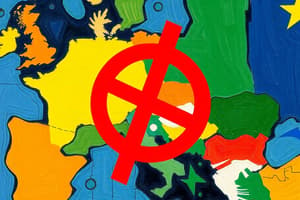Podcast
Questions and Answers
What happens to the price of imports in a small country when a tariff is imposed?
What happens to the price of imports in a small country when a tariff is imposed?
The price of imports rises from $Pw to $Pw + t.
How is the effective rate of protection calculated using value added?
How is the effective rate of protection calculated using value added?
The effective rate of protection is calculated as the change in value added divided by the original value added.
What is the value added in the automobile production example provided?
What is the value added in the automobile production example provided?
The value added is $2,000, calculated as $8,000 (selling price) minus $6,000 (cost of production).
If a 25% tariff is placed on automobiles, what price can home auto assembly firms charge?
If a 25% tariff is placed on automobiles, what price can home auto assembly firms charge?
What are the two main impacts of a tariff on consumers and producers?
What are the two main impacts of a tariff on consumers and producers?
Explain how consumer surplus is affected when a tariff raises prices.
Explain how consumer surplus is affected when a tariff raises prices.
Why might the effective rate of protection be greater than the tariff rate?
Why might the effective rate of protection be greater than the tariff rate?
How can the government benefit from imposing tariffs?
How can the government benefit from imposing tariffs?
What is a specific tariff and provide an example?
What is a specific tariff and provide an example?
What characterizes an ad valorem tariff?
What characterizes an ad valorem tariff?
How does the import demand curve (MD) reflect consumer behavior as prices increase?
How does the import demand curve (MD) reflect consumer behavior as prices increase?
What does the equation MD = D - S represent in the context of international trade?
What does the equation MD = D - S represent in the context of international trade?
Describe the behavior of Home producers' supply as prices increase.
Describe the behavior of Home producers' supply as prices increase.
How does the export supply curve (XS*) change as the price of goods rises?
How does the export supply curve (XS*) change as the price of goods rises?
What is the relationship reflected in the equation XS* = S* - D*?
What is the relationship reflected in the equation XS* = S* - D*?
Explain the impact of trade on wheat prices between Home and Foreign.
Explain the impact of trade on wheat prices between Home and Foreign.
In what ways do tariffs affect government revenue and consumer surplus?
In what ways do tariffs affect government revenue and consumer surplus?
Explain the relationship between terms of trade gains and national welfare under a tariff regime.
Explain the relationship between terms of trade gains and national welfare under a tariff regime.
What are the potential repercussions of retaliatory tariffs from trading partners?
What are the potential repercussions of retaliatory tariffs from trading partners?
How do tariffs impact the quantity supplied, quantity demanded, and the world price in a large country?
How do tariffs impact the quantity supplied, quantity demanded, and the world price in a large country?
What inefficiencies can larger tariffs induce among producers?
What inefficiencies can larger tariffs induce among producers?
What is the relationship between import demand and export supply in equilibrium?
What is the relationship between import demand and export supply in equilibrium?
How does a tariff affect home and foreign prices?
How does a tariff affect home and foreign prices?
What happens to the volume of trade when a tariff is imposed?
What happens to the volume of trade when a tariff is imposed?
In a small country, how does a tariff impact the foreign price?
In a small country, how does a tariff impact the foreign price?
What is consumer surplus and how can it be derived from the demand curve?
What is consumer surplus and how can it be derived from the demand curve?
What is the effect of a tariff on home production and consumption levels?
What is the effect of a tariff on home production and consumption levels?
How does producer surplus differ from consumer surplus?
How does producer surplus differ from consumer surplus?
Explain the equation that represents the quantity of Home imports demanded at tariff levels.
Explain the equation that represents the quantity of Home imports demanded at tariff levels.
Describe the impact of a tariff on consumer surplus.
Describe the impact of a tariff on consumer surplus.
What happens to producer surplus when a tariff is imposed?
What happens to producer surplus when a tariff is imposed?
What does the shift in the Home market price from PW to PT indicate?
What does the shift in the Home market price from PW to PT indicate?
Explain the welfare effects represented by areas b and d in the context of a tariff.
Explain the welfare effects represented by areas b and d in the context of a tariff.
What occurs to Foreign producers and consumers as a result of tariff implementation?
What occurs to Foreign producers and consumers as a result of tariff implementation?
What is represented by area e in the context of tariffs for a 'large' country?
What is represented by area e in the context of tariffs for a 'large' country?
How does an increase in price affect both quantity supplied and producer surplus?
How does an increase in price affect both quantity supplied and producer surplus?
What determines the ambiguous welfare effect of a tariff for a 'large' country?
What determines the ambiguous welfare effect of a tariff for a 'large' country?
Flashcards
Tariff
Tariff
A tax levied on imported goods.
Specific Tariff
Specific Tariff
A tariff charged as a fixed amount for each unit of imported goods. Example: $3 per barrel of oil.
Ad Valorem Tariff
Ad Valorem Tariff
A tariff charged as a percentage of the value of imported goods. Example: 25% tariff on imported trucks.
Import Demand Curve
Import Demand Curve
Signup and view all the flashcards
Export Supply Curve
Export Supply Curve
Signup and view all the flashcards
Equilibrium Price (With Trade)
Equilibrium Price (With Trade)
Signup and view all the flashcards
Pre-Trade Price Difference
Pre-Trade Price Difference
Signup and view all the flashcards
Downward Sloping Import Demand Curve
Downward Sloping Import Demand Curve
Signup and view all the flashcards
World Equilibrium Price
World Equilibrium Price
Signup and view all the flashcards
Tariff Wedge
Tariff Wedge
Signup and view all the flashcards
Small Country Assumption
Small Country Assumption
Signup and view all the flashcards
Free Trade Agreement
Free Trade Agreement
Signup and view all the flashcards
Trade Reduction
Trade Reduction
Signup and view all the flashcards
Large Country Assumption
Large Country Assumption
Signup and view all the flashcards
Domestic Price
Domestic Price
Signup and view all the flashcards
Tariff-Induced Price Rise
Tariff-Induced Price Rise
Signup and view all the flashcards
Consumer Surplus
Consumer Surplus
Signup and view all the flashcards
Producer Surplus
Producer Surplus
Signup and view all the flashcards
Effective Rate of Protection
Effective Rate of Protection
Signup and view all the flashcards
Tariff Revenue
Tariff Revenue
Signup and view all the flashcards
Consumer Surplus Loss
Consumer Surplus Loss
Signup and view all the flashcards
Producer Surplus Gain
Producer Surplus Gain
Signup and view all the flashcards
Net Social Welfare Impact of a Tariff
Net Social Welfare Impact of a Tariff
Signup and view all the flashcards
Government Revenue from Tariffs
Government Revenue from Tariffs
Signup and view all the flashcards
Terms of Trade Gain vs. Efficiency Loss
Terms of Trade Gain vs. Efficiency Loss
Signup and view all the flashcards
Tariff Retaliation
Tariff Retaliation
Signup and view all the flashcards
Wasteful Activities Due to Tariffs
Wasteful Activities Due to Tariffs
Signup and view all the flashcards
Removal of Tariffs
Removal of Tariffs
Signup and view all the flashcards
Geometry of Consumer Surplus
Geometry of Consumer Surplus
Signup and view all the flashcards
Geometry of Producer Surplus
Geometry of Producer Surplus
Signup and view all the flashcards
What is a Tariff?
What is a Tariff?
Signup and view all the flashcards
Effects of Tariffs on Consumer and Producer Surplus
Effects of Tariffs on Consumer and Producer Surplus
Signup and view all the flashcards
Large Country Case: Tariffs and Welfare Effects
Large Country Case: Tariffs and Welfare Effects
Signup and view all the flashcards
Efficiency Loss and Terms of Trade Gain from Tariffs
Efficiency Loss and Terms of Trade Gain from Tariffs
Signup and view all the flashcards
Study Notes
Tariffs
- A tariff is a tax levied on imported goods.
- Specific tariffs are a fixed charge per unit of imported goods.
- Example: $3 per barrel of oil.
- Ad valorem tariffs are levied as a fraction of the value of imported goods.
- Example: 25% tariff on imported trucks.
Supply, Demand, and Trade
-
Tariffs affect single markets, such as the wheat market.
-
Without trade, the price of wheat in one country (Home) might be higher than in a foreign country.
-
Trade allows wheat to move until price differences are eliminated.
-
The import demand curve shows the difference between the quantity of a good demanded by consumers and the quantity supplied by domestic producers at each price.
- MD = D – S
- The curve slopes downward, meaning quantity demanded decreases as price rises.
-
The export supply curve shows the difference in the quantity of a good Foreign producers supply and Foreign consumers demand at a given price.
- XS* = S* – D*
- The curve slopes upwards, meaning quantity supplied increases as price rises.
-
In equilibrium import demand equals export supply.
-
In equilibrium the sum of home demand and foreign demand equals the sum of home supply and foreign supply.
-
World demand equals world supply.
Effects of a Tariff
- A tariff acts like a transportation cost.
- Domestic sellers are unwilling to ship goods unless the domestic price exceeds the foreign price by the amount of the tariff.
- P₁ - t = P₁*
- A tariff raises the price of a good in the importing country and lowers the price in the exporting country.
- The volume of trade declines with a tariff.
Effects of a Tariff (Small Country)
- In a "small" country, a tariff has no effect on the foreign price, which stays the same (Pw).
- The price in the domestic market rises by the full amount of the tariff (P₁ = P + t). W
Measuring the Amount of Protection
- The effective rate of protection measures the amount of protection a tariff (or other trade policy) provides.
- Effective rates often differ from tariff rates due to indirect effects on other sectors.
- Example: A tariff on automobiles considers the value added of factors in production.
- Example: If a 25% tariff on imported autos raises their home price from $8,000 to $10,000 but factors in production are only worth $6,000, then the effective rate is 100%.
Costs and Benefits of Tariffs
- Tariffs raise the price of imported goods in the importing country, benefiting domestic producers but harming consumers.
- Governments collect tariff revenue.
- Welfare analysis using consumer and producer surplus, and efficiency loss.
- The tariff could lead to an efficiency loss.
- The tariff could cause a terms of trade gain.
Consumer and Producer Surplus
- Consumer Surplus: Measures the difference between the maximum price consumers would be willing to pay and the actual price.
- Producer Surplus: Measures the difference between the actual price and the minimum price producers would be willing to accept.
Studying That Suits You
Use AI to generate personalized quizzes and flashcards to suit your learning preferences.




